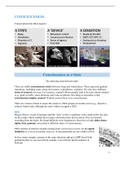CONSCIOUSNESS
Consciousness has three aspects:
Consciousness as a State
“the annoying state between naps”
There are subtle consciousness states between sleep and wakefulness. These represent gradual
transitions, including coma, sleep, drowsiness, wakefulness, vigilance. We also have different
states of arousal over time. For instance, around 4.00 pm people tend to be more absent minded
(e.g., peak in traffic, more domestic and work accidents). One thing to remember is that
consciousness implies arousal. Without arousal there is no consciousness.
There are various criteria to assess the extent to which people are awake or not (e.g., objective,
clinical, behavioral), although the most widely accepted is EEG.
EEG
Berger (first to record in humans) had the “luck” to have a gardener with a skull defect (no skin
on the scalp), which enabled him to place electrodes there and record as if he was directly
recording from the brain. He found different wave frequencies (from low to high: delta, theta,
alpha, beta, gamma), associated to different states of consciousness.
EEG consists of selective signals coming from synchronous activity on the apical
dendrites of cortical pyramidal neurons. Action potentials are not visible in EEG.
In fact, many synaptic currents in the same direction add up to LFP (local field
potentials) that we can record from outside, even with the skull (insulator) in
between.
1
,EEG and States of Consciousness
To assess consciousness with electrophysiology, we use polysomnography. This consists in the
simultaneous recording of EEG, EMG (muscle tone), and EOG (i.e., electrooculogram; eye
movements).
High muscle tone refers to high muscle activity.
Here, although we don’t have saccades, eyes ‘drift’ (are
not completely still). As for movement, muscle tone is
flat, indicating a state of relaxation or ~paralysis.
This state’s activity resembles wakefulness. The
difference is that here we have flat muscle tone
(paralysis).“if you ask them ‘how are you?’, they won’t respond”
Sleep Patterns
The image below represents a normal sleep pattern. The dips indicate deep sleep whereas the
black solid lines indicate REM sleep. We can see how we quickly go into deep stages of sleep
soon after we fall asleep. As the night goes on, sleep gets lighter (less dips) and REM sleep
stages get longer.
All in all, sleep cycles last about 90 minutes and we have more deep sleep early at night and
more REM sleep later at night.
Sleep walking mostly occurs in the deepest stages of sleep (usually in Stage 4, about an hour into
sleep).
2
,Sleep Disorders
• Sleep Paralysis
Awake but paralyzed (flat muscle tone).
• Sleep Violence
REM sleep without muscle paralysis: acting out dreams (violent movements during sleep).
Affects 1% of the population (1 in 100 people have it).
• Narcolepsy
Sudden REM sleep onset (awake but suddenly muscles get paralyzed and you fall asleep).
• Sleepwalking
‘wake up’ during deep sleep and typically perform automated behaviors (e.g., driving,
urinating, preparing meals, walking around the house). Affects 1-5% of the population,
mostly children. Contributing factor are stress, worries, and sleep deprivation.
From an electrophysiological perspective, EEG activity is in deep sleep mode while EMG
and EOG activity suddenly rise during sleepwalking. This means that the frontal cortex is
shut down during sleepwalking compared to wakefulness (sleepwalking ≠ awake).
We then look at the example of Lee Hadwin (draws during sleep) and Victor goes: “he
draws like a maniac while he is actually asleep”. Sleepwalking is quite a mysterious
phenomenon.
Since dreams (“conscious” experiences) only occur in REM sleep and sleepwalking occurs
in deep sleep (no dreams), we could say that sleepwalkers are unconscious.
3
, Questions to Victor:
Is dreaming being consciously awake or not?
On one hand it is, since you are experiencing the dream. On the other, this experience is completely dissociated
from what is happening in your surrounds (unless with lucid dreaming: you incorporate the things that happen
in your environment). However, the fact that this is all introspective evidence makes dreams hard to explore.
Moreover, sleeping is dangerous for many other animals (some animals sleep with half their brain
alternatively). This is “one of the weirdest phenomena on the planet”.
Neurological difference between dreaming and imagining?
They are sort of similar (visual experience is the main component) since they both involve visual cortex. When
you are dreaming, you have the idea that you are really there.
🌙 🌙 🌙 🌙 🌙 🌙 🌙 🌙 🌙 🌙 🌙 🌙 🌙 🌙 🌙 🌙 🌙 🌙 🌙 🌙 🌙 🌙
Sleep & Arousal in the Brain
The MRF (medial reticular formation), also referred to as RAS (reticular activating system)
or simply reticular formation, is a set of brainstem nuclei involved in arousal.
The MRF projects to the cortex, which in turn releases modulatory neurotransmitters.
This system is really critical for maintaining consciousness. The MRF projects to the cortex
either directly or indirectly (via the intralaminar nuclei of the thalamus). One of the nuclei
involved is the LC (locus coeruleus), which projects to the cortex, stimulating the release of NA.
Experiment
Effects of electrical stimulation of MRF in anesthetized cats:
1. More high-frequency (gamma) EEG relative to low-frequency (delta)
2. Variable firing rates
3. More high-frequency oscillations
4. Increased synchrony of neural oscillations
These effects resemble being awake from a neural perspective. So, despite the cat is
anesthetized, stimulating the MRF causes it to neurally wake up.
4





